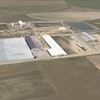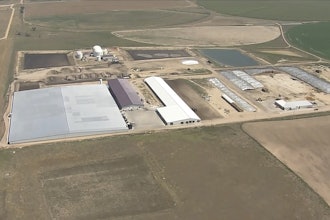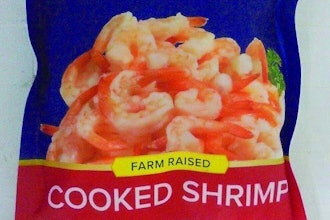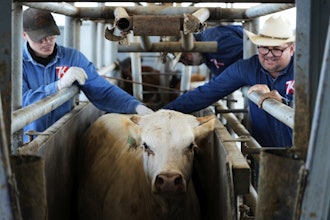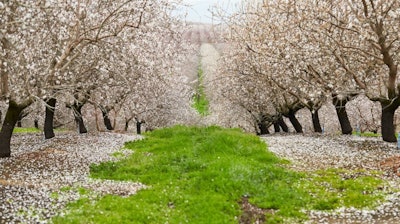
The Almond Board of California (ABC) announced a $6.8 million investment in 75 independent research projects exploring next-generation farming practices including optimal use of everything almond orchards grow. In addition to improving production practices, the research projects help the California almond community provide almond lovers around the world with a safe, wholesome and sustainable product.
The announcement was made at the 46th annual Almond Conference, an event held in Sacramento, Calif., convening almond farmers, processors and researchers to discuss the latest science behind responsible almond farming. ABC's research programs provide a scientific basis for best practices across several priority areas, including water sustainability, pollinator health and finding new uses for almond coproducts, including hulls, shells and woody material.
"Innovation is at the core of sustainable almond farming. Driven by family farmers, the almond community is committed to continuous improvement, ensuring a better environment and future for our children and grandchildren, neighbors and employees," said Almond Board of California President and CEO, Richard Waycott. "Since 1973 almond farmers and processors have invested $80 million in research through the Almond Board to improve our understanding of almonds' impact on human health, ensure food quality and safety, and improve farming practices while minimizing environmental impacts."
Finding New Uses for Almond Coproducts
Almonds grow in a shell, protected by a hull, on a tree. Farmers have always taken responsibility for these coproducts, ensuring they are put to beneficial use rather than sent to landfill. Today, the California almond community is focusing research investment on optimal uses for these coproducts, embracing a zero-waste approach that addresses critical needs across multiple industries.
This year ABC funded nine coproducts-focused research projects totaling $1.2 million with applications spanning from in-orchard utilization to value-added uses.
"We enjoy working with the almond community because their goals align with ours. The Almond Board is investing in research so nothing goes to waste, with the goal of a neutral footprint," said Lydia Palma, researcher and PhD student at University of California, Davis. "Our research partnership focuses on developing new technologies to convert almond coproducts into valuable products."
Three ongoing almond coproduct research projects showing promising results are:
- Recycled Polypropylene-Polyethylene Torrified Almond Shell Biocomposites. USDA-ARS, Western Regional Research Center1 – Almond shells have traditionally been used as livestock bedding. This research explores how almond shells, transformed to a charcoal-like powder through a process known as torrefaction, can serve as a strengthening agent and colorant for post-consumer recycled plastics.
- Cultivation of Black Soldier Fly Larvae on Almond Byproducts. University of California, Davis2 – Almonds' sugary, fibrous hulls can feed animals big and small, including the emerging world of insect farming. This research project explores raising black soldier fly larvae, used as a feedstock for poultry and aquaculture, on almond hulls.
- Almond Hull Byproducts as a Casing Amendment Material in Mushroom Cultivation. USDA-ARS, Western Regional Research Center3 – With their sugars removed for other uses, the remaining hull material can serve as an alternative to traditional peat moss for mushroom cultivation. This research project explores using almond hulls as a growing medium for commercial mushrooms, with preliminary results showing several benefits including optimal water absorption and increased yields.
"Creating new ways to use a product that has historically been thought of as a single-use item is very exciting," said Mike Curry, almond huller/sheller with Johnson Farms. "The entire production and supply chain, including the consumer, will benefit from the development of new products from almond hulls and shells."
Additional Opportunities for Innovation
Commitment to scientific research supports the California almond community in growing the farm of the future. To improve water sustainability, farmers are adopting precision irrigation technology and exploring replenishing underground aquifers through on-farm groundwater recharge. To ensure the safety of honey bees, essential to pollinating almonds, farmers work closely with beekeepers and follow research-based best practices. Research continues to fine-tune the optimal approach to planting bee pastures which supply additional nutrition to bee hives and other nearby pollinators.
Water and honey bee-focused research projects funded by ABC this year include $610,000 to nine water projects and $579,000 to seven honey bee health projects. This builds upon more than 200 water research projects funded since 1982, helping farmers reduce the water needed to grow a pound of almonds by 33% over the past 20 years4 and, with 120 projects funded to date, ABC has supported more honey bee health research than any other crop group.5
Almond Board research projects are funded through an assessment paid per pound of almonds produced. After review by research advisors and workgroups focused on distinct almond farming topics, projects are selected by a committee of almond farmers and processors based on strategic alignment to industry needs and anticipated impact of the research.


